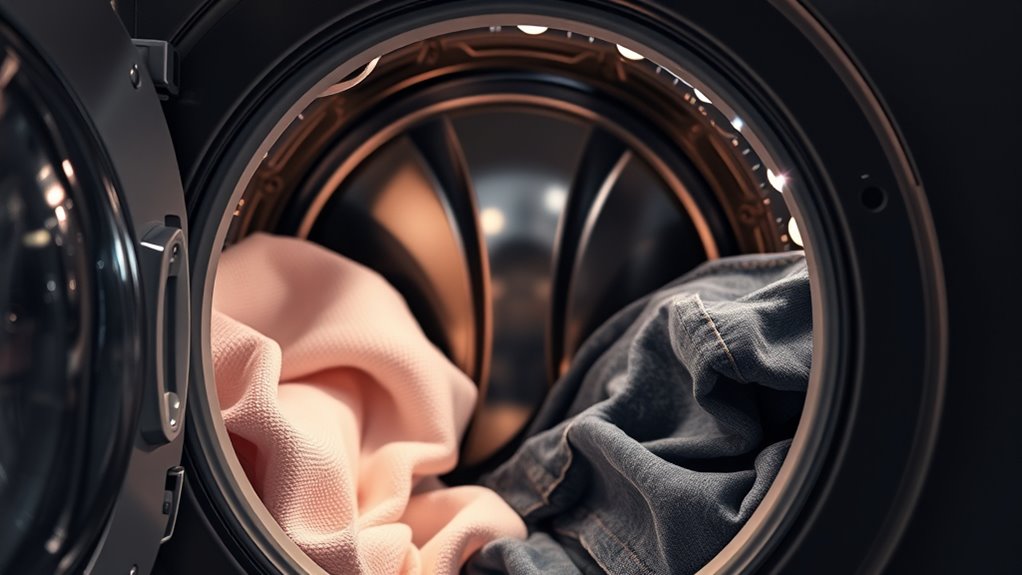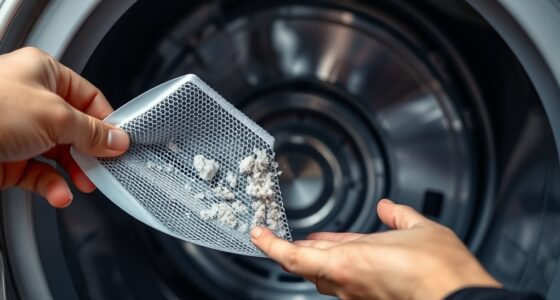Understanding wash cycles helps you pick the right settings to protect your fabrics and get them clean. For delicate items like lace or silk, choose a gentle cycle with cool water to prevent damage. Heavy-duty cycles use warmer water and vigorous agitation for items like towels and jeans. Normal cycles suit most clothing. Learning when and how to use each cycle guarantees your laundry stays in great shape — keep exploring to master these options.
Key Takeaways
- Different wash cycles are designed for specific fabric types and cleaning needs, such as delicate, heavy-duty, and normal settings.
- The delicate cycle uses gentle agitation and cooler water to protect fragile fabrics like lace and silk.
- Heavy-duty cycles employ longer wash times, higher water levels, and vigorous agitation for sturdy items like towels and jeans.
- Proper cycle selection prevents fabric damage, preserves clothing quality, and ensures effective cleaning.
- Using appropriate water temperatures and adding fabric softeners at the right cycle phase enhances laundry results.

Choosing the right wash cycle is vital to effectively clean your clothes without causing damage. It’s not just about pressing the start button; understanding how different cycles work can help you preserve your clothing’s quality and extend its lifespan. For example, when using fabric softeners, you want to confirm they’re compatible with the cycle you select. Many cycles, especially delicate ones, are designed to be gentle on fabrics, preventing wear and tear. Meanwhile, heavier cycles are better suited for sturdy items like towels and jeans that can handle more agitation. Water temperature also plays a vital role here. In most cases, warm or hot water helps remove dirt and oils more effectively, but it can also weaken fibers and cause colors to fade if not used carefully. Cold water cycles, on the other hand, are gentler and help preserve fabric softeners’ integrity while protecting delicate materials from shrinking or damage.
When you opt for a delicate wash cycle, you’re choosing a gentle process that minimizes agitation and uses cooler water settings. This cycle is perfect for fragile fabrics like lace, silk, or other fine materials. Using fabric softeners during these cycles can help keep the fabrics soft and static-free, but you should always check the product label to confirm it’s suitable for delicate items. For heavier loads, such as bedding or heavily soiled work clothes, a heavy-duty cycle is your best bet. These cycles typically involve longer wash times, higher water levels, and more vigorous agitation, which helps loosen dirt and grime effectively. Here, warmer water temperatures are often employed to break down oils and dirt more efficiently, but you need to be cautious with fabrics that may bleed or shrink. Always follow the care instructions on your garments to determine the suitable water temperature and cycle.
For everyday laundry, using a normal or regular cycle strikes a good balance between cleaning power and fabric care. These cycles usually run at moderate speeds and temperatures, making them versatile for most clothing types. When using fabric softeners in these cycles, it’s best to add them during the rinse phase, ensuring they don’t interfere with the cleaning process. Remember, the water temperature you select should match the fabric care labels—hot for whites and heavily soiled items, warm for mixed loads, and cold for delicate or colorful garments. Mastering how these settings work together guarantees your laundry comes out clean, vibrant, and undamaged every time. Additionally, understanding the role of attention in the process can improve your overall laundry results, just as focused attention enhances creativity in other endeavors.
Frequently Asked Questions
How Do I Choose the Right Cycle for Mixed Fabrics?
To choose the right cycle for mixed fabrics, you should select a gentle or mixed load setting to protect delicate items while cleaning sturdier fabrics thoroughly. Always check fabric care labels for specific washing tips, and consider using cold water to prevent damage. This approach helps prevent wear and tear, keeps colors vibrant, and ensures your clothes last longer. When in doubt, opt for a gentle cycle to safeguard all fabric types.
Can I Customize Wash Cycle Settings on My Machine?
Yes, you can customize wash cycle settings on your machine. Most modern washers allow cycle customization through setting adjustments, giving you control over water temperature, spin speed, and cycle duration. Check your user manual or control panel for options to modify default settings. By customizing your wash cycle, you guarantee your clothes get the right care, especially when dealing with mixed fabrics or delicate items.
What Does “Extra Rinse” Do in Different Cycles?
Extra rinse adds an extra splash of water, making sure every tiny droplet of detergent, fabric softener, and dirt gets washed away. It’s like giving your clothes a thorough spa treatment, especially if you use heavy-duty or eco-friendly detergent types. This extra step can lengthen your cycle duration, but it guarantees fresher, cleaner clothes, perfect for sensitive skin or stubborn stains. You’ll love the difference it makes!
Are There Eco-Friendly Wash Cycle Options?
Yes, there are eco-friendly wash cycle options on your machine. You can choose cycles labeled as “eco” or “energy saving modes,” which use less water and electricity. To maximize eco-friendliness, pair these cycles with eco-friendly detergents. These options help reduce your environmental impact while still thoroughly cleaning your clothes. Always check your washer’s settings to find the most sustainable options available for your needs.
How Often Should I Use the Delicate Cycle?
You should use the delicate cycle about once a week or when washing fragile fabrics to guarantee fabric preservation. It’s best to avoid overusing it, as frequent washing can wear down delicate fibers. Adjust your laundry frequency based on how often you wear or use delicate items, and always follow the care labels. This way, you protect your clothes and extend their lifespan while maintaining their quality.
Conclusion
Now you know the nuances of wash cycles—delicate, heavy-duty, and beyond. By choosing the correct cycle, you protect fabrics, prolong laundry life, and perfect your process. Remember, mindful method matters; matching materials with methods makes a difference. So, stay savvy, select smart cycles, and see your shirts shimmer and sheets stay splendid. With this knowledge, laundry loads become less laborious and more lovely, leaving you confident and content with every cycle every time.









